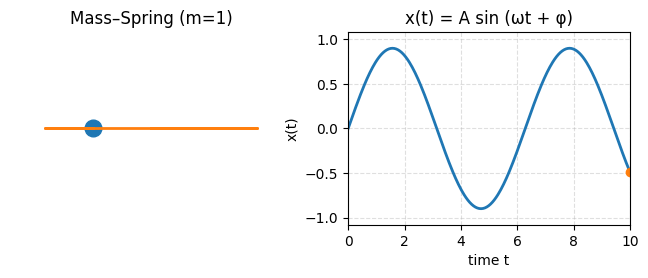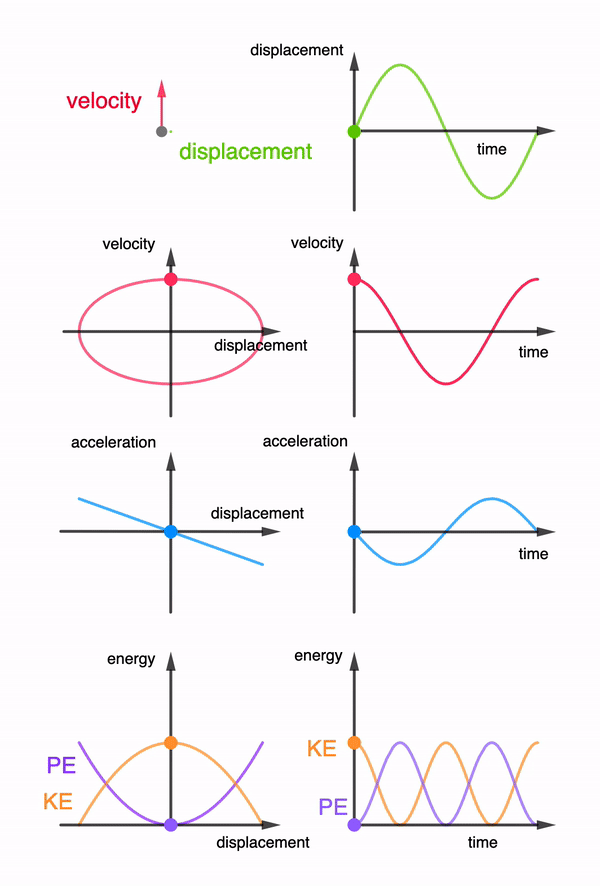Classical Harmonic Oscillator#
What You Need to Know
Equation of Motion:
Derived from Hooke’s law, \(F = -kx\), leading to the second-order differential equation \( m \ddot{x} + kx = 0 \) governing simple harmonic motion (SHM).
Solution to the Oscillator:
The general solution is \( x(t) = A \cos(\omega t + \phi) \), with \( \omega = \sqrt{k/m} \). The amplitude \( A \) and phase \( \phi \) depend on initial conditions.
Energy in Oscillation:
Kinetic energy, \( T = \frac{1}{2} m v^2 \), and potential energy, \( U = \frac{1}{2} k x^2 \), exchange throughout the motion, while total energy remains constant.
Oscillation Parameters:
Key parameters include angular frequency \( \omega \), frequency \( f = \frac{\omega}{2\pi} \), and period \( T = \frac{2\pi}{\omega} \).
Damped and Driven Oscillations:
Discuss damping (energy dissipation) and resonance in driven systems, highlighting underdamped, overdamped, and critically damped cases.
Examples and Applications:
Includes mass-spring systems, pendulums (small angles), and LC circuits. Emphasizes the harmonic oscillator’s role in describing oscillations across different physical systems.
Bead, spring and a wall.#
The classical harmonic oscillator is a system of bead attached to a wall with a spring.
When bead is displaced from its equilibrium or resting position \(r_0\) to some point \(r\), experiences a restoring force \(F\) proportional to the displacement \(x=r-r_0\):

Fig. 59 Illustration of harmonic motion governed by Hook’s law. Any deviation from equilibrium (resting) position is met with restoring force. In the absence of friction the bead keeps oscillating around equilibrium position.#
This is Hooke’s law, where minus sign indicates that the direction of force is always towards restoring equilibrium location.
The constant k characterizes stiffness of the spring and is called spring constant.
Solving harmonic oscillator problem#
The classical equation of motion for a one-dimensional simple harmonic oscillator with a particle of mass m attached to a spring having spring constant k generates mechanical waves.
The intorduced constant \(\omega\) will be seen as the frequency oscillations.Note that frequency is inversly porportional to mass (heavier objects with same spring constant oscillate rapdily around equilibrium) and proprotional to spring constant (stiffer springs increase oscillations around equilibrium for same mass)
The differneital equation is a simple second order, linear ODE which can be solved by a standard trick of pluggin exponential \(x(t)=e^{\alpha t}\) and convertin the problem to algebraic equation. The solution is
The two constnants are: \(A\) the amplitude of oscillations and \(\phi\) is constant specifying the initial position of the bead.
Show code cell source
import numpy as np
import matplotlib.pyplot as plt
from matplotlib.animation import FuncAnimation
from IPython.display import HTML
def sho_anim(m, k=1.0, A=0.9, phi=0.0, duration=4.0, fps=30):
ω = np.sqrt(k/m)
t = np.linspace(0, duration, int(fps*duration))
x = A*np.sin(ω*t + phi)
fig, axes = plt.subplots(1, 2, figsize=(8, 2.5))
ax_mass, ax_wave = axes
# --- left: oscillating mass ---
ax_mass.set_xlim(-1.2, 1.2)
ax_mass.set_ylim(-0.5, 0.5)
ax_mass.axis("off")
ax_mass.set_title(f"Mass–Spring (m={m:g})")
(mass_point,) = ax_mass.plot([], [], "o", ms=12)
(trace_line,) = ax_mass.plot([], [], lw=2)
# --- right: sinusoidal wave ---
ax_wave.set_xlim(0, duration)
ax_wave.set_ylim(-1.2*A, 1.2*A)
ax_wave.set_xlabel("time t")
ax_wave.set_ylabel("x(t)")
ax_wave.grid(True, ls="--", alpha=0.4)
ax_wave.set_title("x(t) = A sin (ωt + φ)")
(wave_line,) = ax_wave.plot([], [], lw=2)
(wave_point,) = ax_wave.plot([], [], "o")
def init():
for line in (mass_point, trace_line, wave_line, wave_point):
line.set_data([], [])
return mass_point, trace_line, wave_line, wave_point
def update(i):
xi = x[i]
mass_point.set_data([xi], [0])
trace_line.set_data(x[:i+1], np.zeros(i+1))
wave_line.set_data(t[:i+1], x[:i+1])
wave_point.set_data([t[i]], [xi])
return mass_point, trace_line, wave_line, wave_point
return FuncAnimation(fig, update, init_func=init, frames=len(t), interval=1000/fps, blit=True)
# --- Two animations: normal mass and heavier mass ---
anim1 = sho_anim(m=1.0, duration=10.0)
anim2 = sho_anim(m=10.0, duration=10.0) # slower oscillation
# Inline display in Jupyter / Jupyter Book
plt.close() # Prevents static display of the last frame
HTML(anim1.to_jshtml() + "<br><hr><br>" + anim2.to_jshtml())
---------------------------------------------------------------------------
KeyboardInterrupt Traceback (most recent call last)
Cell In[1], line 53
51 # Inline display in Jupyter / Jupyter Book
52 plt.close() # Prevents static display of the last frame
---> 53 HTML(anim1.to_jshtml() + "<br><hr><br>" + anim2.to_jshtml())
File /opt/hostedtoolcache/Python/3.8.18/x64/lib/python3.8/site-packages/matplotlib/animation.py:1352, in Animation.to_jshtml(self, fps, embed_frames, default_mode)
1348 path = Path(tmpdir, "temp.html")
1349 writer = HTMLWriter(fps=fps,
1350 embed_frames=embed_frames,
1351 default_mode=default_mode)
-> 1352 self.save(str(path), writer=writer)
1353 self._html_representation = path.read_text()
1355 return self._html_representation
File /opt/hostedtoolcache/Python/3.8.18/x64/lib/python3.8/site-packages/matplotlib/animation.py:1103, in Animation.save(self, filename, writer, fps, dpi, codec, bitrate, extra_args, metadata, extra_anim, savefig_kwargs, progress_callback)
1100 for data in zip(*[a.new_saved_frame_seq() for a in all_anim]):
1101 for anim, d in zip(all_anim, data):
1102 # TODO: See if turning off blit is really necessary
-> 1103 anim._draw_next_frame(d, blit=False)
1104 if progress_callback is not None:
1105 progress_callback(frame_number, total_frames)
File /opt/hostedtoolcache/Python/3.8.18/x64/lib/python3.8/site-packages/matplotlib/animation.py:1139, in Animation._draw_next_frame(self, framedata, blit)
1137 self._pre_draw(framedata, blit)
1138 self._draw_frame(framedata)
-> 1139 self._post_draw(framedata, blit)
File /opt/hostedtoolcache/Python/3.8.18/x64/lib/python3.8/site-packages/matplotlib/animation.py:1164, in Animation._post_draw(self, framedata, blit)
1162 self._blit_draw(self._drawn_artists)
1163 else:
-> 1164 self._fig.canvas.draw_idle()
File /opt/hostedtoolcache/Python/3.8.18/x64/lib/python3.8/site-packages/matplotlib/backend_bases.py:2082, in FigureCanvasBase.draw_idle(self, *args, **kwargs)
2080 if not self._is_idle_drawing:
2081 with self._idle_draw_cntx():
-> 2082 self.draw(*args, **kwargs)
File /opt/hostedtoolcache/Python/3.8.18/x64/lib/python3.8/site-packages/matplotlib/backends/backend_agg.py:400, in FigureCanvasAgg.draw(self)
396 # Acquire a lock on the shared font cache.
397 with RendererAgg.lock, \
398 (self.toolbar._wait_cursor_for_draw_cm() if self.toolbar
399 else nullcontext()):
--> 400 self.figure.draw(self.renderer)
401 # A GUI class may be need to update a window using this draw, so
402 # don't forget to call the superclass.
403 super().draw()
File /opt/hostedtoolcache/Python/3.8.18/x64/lib/python3.8/site-packages/matplotlib/artist.py:95, in _finalize_rasterization.<locals>.draw_wrapper(artist, renderer, *args, **kwargs)
93 @wraps(draw)
94 def draw_wrapper(artist, renderer, *args, **kwargs):
---> 95 result = draw(artist, renderer, *args, **kwargs)
96 if renderer._rasterizing:
97 renderer.stop_rasterizing()
File /opt/hostedtoolcache/Python/3.8.18/x64/lib/python3.8/site-packages/matplotlib/artist.py:72, in allow_rasterization.<locals>.draw_wrapper(artist, renderer)
69 if artist.get_agg_filter() is not None:
70 renderer.start_filter()
---> 72 return draw(artist, renderer)
73 finally:
74 if artist.get_agg_filter() is not None:
File /opt/hostedtoolcache/Python/3.8.18/x64/lib/python3.8/site-packages/matplotlib/figure.py:3175, in Figure.draw(self, renderer)
3172 # ValueError can occur when resizing a window.
3174 self.patch.draw(renderer)
-> 3175 mimage._draw_list_compositing_images(
3176 renderer, self, artists, self.suppressComposite)
3178 for sfig in self.subfigs:
3179 sfig.draw(renderer)
File /opt/hostedtoolcache/Python/3.8.18/x64/lib/python3.8/site-packages/matplotlib/image.py:131, in _draw_list_compositing_images(renderer, parent, artists, suppress_composite)
129 if not_composite or not has_images:
130 for a in artists:
--> 131 a.draw(renderer)
132 else:
133 # Composite any adjacent images together
134 image_group = []
File /opt/hostedtoolcache/Python/3.8.18/x64/lib/python3.8/site-packages/matplotlib/artist.py:72, in allow_rasterization.<locals>.draw_wrapper(artist, renderer)
69 if artist.get_agg_filter() is not None:
70 renderer.start_filter()
---> 72 return draw(artist, renderer)
73 finally:
74 if artist.get_agg_filter() is not None:
File /opt/hostedtoolcache/Python/3.8.18/x64/lib/python3.8/site-packages/matplotlib/axes/_base.py:3028, in _AxesBase.draw(self, renderer)
3025 for spine in self.spines.values():
3026 artists.remove(spine)
-> 3028 self._update_title_position(renderer)
3030 if not self.axison:
3031 for _axis in self._axis_map.values():
File /opt/hostedtoolcache/Python/3.8.18/x64/lib/python3.8/site-packages/matplotlib/axes/_base.py:2972, in _AxesBase._update_title_position(self, renderer)
2970 top = max(top, bb.ymax)
2971 if title.get_text():
-> 2972 ax.yaxis.get_tightbbox(renderer) # update offsetText
2973 if ax.yaxis.offsetText.get_text():
2974 bb = ax.yaxis.offsetText.get_tightbbox(renderer)
File /opt/hostedtoolcache/Python/3.8.18/x64/lib/python3.8/site-packages/matplotlib/axis.py:1335, in Axis.get_tightbbox(self, renderer, for_layout_only)
1333 if renderer is None:
1334 renderer = self.figure._get_renderer()
-> 1335 ticks_to_draw = self._update_ticks()
1337 self._update_label_position(renderer)
1339 # go back to just this axis's tick labels
File /opt/hostedtoolcache/Python/3.8.18/x64/lib/python3.8/site-packages/matplotlib/axis.py:1277, in Axis._update_ticks(self)
1275 major_labels = self.major.formatter.format_ticks(major_locs)
1276 major_ticks = self.get_major_ticks(len(major_locs))
-> 1277 self.major.formatter.set_locs(major_locs)
1278 for tick, loc, label in zip(major_ticks, major_locs, major_labels):
1279 tick.update_position(loc)
File /opt/hostedtoolcache/Python/3.8.18/x64/lib/python3.8/site-packages/matplotlib/ticker.py:701, in ScalarFormatter.set_locs(self, locs)
699 if len(self.locs) > 0:
700 if self._useOffset:
--> 701 self._compute_offset()
702 self._set_order_of_magnitude()
703 self._set_format()
File /opt/hostedtoolcache/Python/3.8.18/x64/lib/python3.8/site-packages/matplotlib/ticker.py:708, in ScalarFormatter._compute_offset(self)
706 locs = self.locs
707 # Restrict to visible ticks.
--> 708 vmin, vmax = sorted(self.axis.get_view_interval())
709 locs = np.asarray(locs)
710 locs = locs[(vmin <= locs) & (locs <= vmax)]
File /opt/hostedtoolcache/Python/3.8.18/x64/lib/python3.8/site-packages/matplotlib/axis.py:2255, in _make_getset_interval.<locals>.getter(self)
2253 def getter(self):
2254 # docstring inherited.
-> 2255 return getattr(getattr(self.axes, lim_name), attr_name)
File /opt/hostedtoolcache/Python/3.8.18/x64/lib/python3.8/site-packages/matplotlib/axes/_base.py:857, in _AxesBase.viewLim(self)
855 @property
856 def viewLim(self):
--> 857 self._unstale_viewLim()
858 return self._viewLim
File /opt/hostedtoolcache/Python/3.8.18/x64/lib/python3.8/site-packages/matplotlib/axes/_base.py:844, in _AxesBase._unstale_viewLim(self)
841 def _unstale_viewLim(self):
842 # We should arrange to store this information once per share-group
843 # instead of on every axis.
--> 844 need_scale = {
845 name: any(ax._stale_viewlims[name]
846 for ax in self._shared_axes[name].get_siblings(self))
847 for name in self._axis_names}
848 if any(need_scale.values()):
849 for name in need_scale:
KeyboardInterrupt:

Energy of the harmonic oscillator#
In classical mechanics when we have a conservative system (no frictions, energy conserved) the force is a gradient of a potential energy
This means the steeper the potential the higher the force and minus sign indicates that force is restoring system to its equilibrium position.
The potential energy can be obtained by integrating:
Thus the potential energy for a simple harmonic oscillator is a parabolic function of displacement. It is convenient to set \(C=0\) and measure potential energy relative to equilibrium state \(V(x=0)=0\)
The total energy consisting of kinetic and potential enregies will be used to obtain Schordinger equation.

Fig. 60 The harmonic oscilator (in a vacuum) is a conservative system becasue the kinetic and potential energies keep being interconverted with no amount of total energy being dissipated into the environment. Oscillations go on forever with position \(x(t)\) velocity \(v=\dot{x}(t)\) and acceleration \(a=\ddot{x(t)}\) with same constant frequency \(\omega\) but with different amplitudes.#
Diatomic molecules and two-body problem#
Diatomic molecule is stable because the same force is acting on both ends
By expressing equations of motion in terms of the center of mass which, we find that center of mass moves freely without acceleration.
Next by taking difference between coordinates \(\ddot{x_2}=-\frac{k}{m_2}x_2\) and \(\ddot{x_1}=\frac{k}{m_1}x_1\)we expres the equations of motion in terms of relative distance
This equation looks identical to the probem of bead anchored to wall with a spring. We have thus managed to reduce the two body probelm to a one modey problem by replacing masses of bodies with a reduced mass: \(\mu=\frac{1}{m_1}+\frac{1}{m_2}=\frac{m_1 m_2}{m_1+m_2}\)
### Beads and springs model of molecules
- Before discussing the harmonic oscillator approximation let us reflect on when this would be a good approximation and uner which cirumstances it will break down? For an aribtarry potential energy funciton of x we can carry out Taylor's expansion around equilibrium bond length $x_0$ obtaining infinitey series.
$$U(x) = U(x_0)+U'(x_0)(x-x_0)+\frac{1}{2!}U''(x_0)(x-x_0)^2+\frac{1}{3!}U'''(x_0)(x-x_0)^3+...$$
:::{figure-md} markdown-fig
<img src="images/harm_approx.png" alt="harmls" class="bg-primary mb-1" width="300px">
Deviation from simple harmonic potential approximation (red curve) of true/exact potential (blue curve) with cubic term (green)
Setting energy scale to be relative to \(U(x_0)=0\) and recongizing that first derivative vanishes at minima \(x_0\) we have
Hence we see that the Harmonic approximation is only the first non vanishing term! Furthermore we see that spring constant k and subsequent anharmonicity consnats such as \(\gamma\) are higher order derivatives of potential energy. That is the more non-linear the potential the higer the contribution of these terms. And vice verse clsoer the potential to quadratic form the more accurate is the harmonic assumtion.
Show code cell source
import numpy as np
import matplotlib.pyplot as plt
# Define the range for x values, focusing on the dissociation region
x = np.linspace(0, 2.5, 500)
# Define the harmonic potential (quadratic term)
harmonic = 0.5 * x**2
# Define the harmonic + cubic potential
harmonic_cubic = 0.5 * x**2 - 0.2 * x**3
# Define the harmonic + cubic + quartic potential
harmonic_cubic_quartic = 0.5 * x**2 - 0.2 * x**3 + 0.05 * x**4
# Define the harmonic + cubic + quartic + higher-order polynomial (5th and 6th order)
polynomial_approx = 0.5 * x**2 - 0.2 * x**3 + 0.05 * x**4 - 0.01 * x**5 + 0.001 * x**6
# Define the Morse potential
def morse_potential(x, D=1, a=1):
return D * (1 - np.exp(-a * x))**2
# Set parameters for Morse potential
D = 1 # Depth of the potential well
a = 1 # Width of the potential well
# Compute Morse potential
morse = morse_potential(x, D, a)
# Plot all the potentials, showing progression
plt.figure(figsize=(8, 6))
# Harmonic only
plt.plot(x, harmonic, label='Harmonic: $0.5 x^2$', color='b', lw=2)
# Harmonic + Cubic
plt.plot(x, harmonic_cubic, label='Harmonic + Cubic: $0.5 x^2 - 0.2 x^3$', color='g', lw=2)
# Harmonic + Cubic + Quartic
plt.plot(x, harmonic_cubic_quartic, label='Harmonic + Cubic + Quartic: $0.5 x^2 - 0.2 x^3 + 0.05 x^4$', color='r', lw=2)
# Polynomial approximation (up to 6th order)
plt.plot(x, polynomial_approx, label='Polynomial Approx (up to $x^6$)', color='c', lw=2)
# Morse potential
plt.plot(x, morse, label='Morse Potential', color='k', lw=3)
# Add labels and legend
plt.title('Polynomial Approximation of Harmonic Oscillator vs. Morse Potential')
plt.xlabel('x (dissociation region)')
plt.ylabel('Potential Energy')
plt.axhline(0, color='black',linewidth=0.5)
plt.axvline(0, color='black',linewidth=0.5)
plt.grid(True)
plt.legend()
plt.ylim([0, 2])

